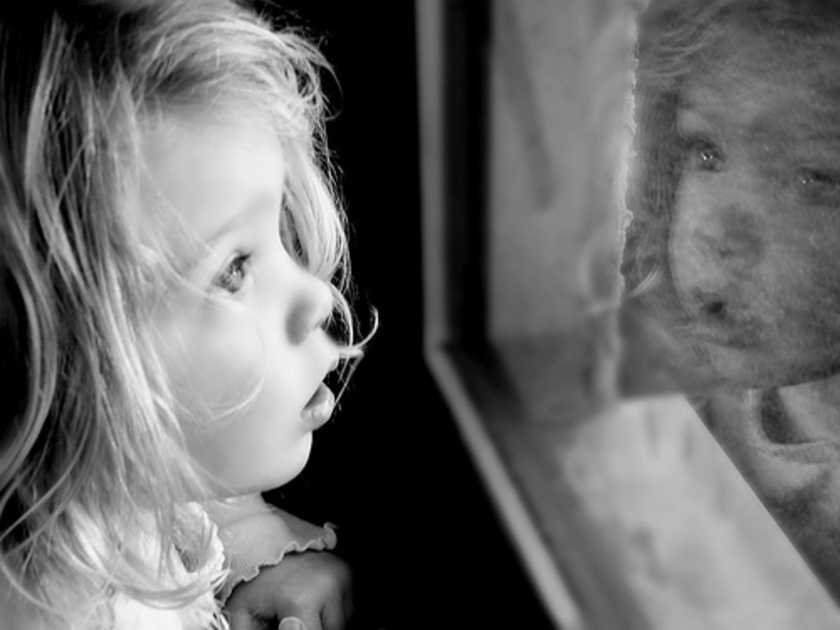
Exactly who are you? You are indeed unique, and no one else is quite the same. But what makes you you? Well, part of the answer is your appearance. Other people spot you in a crowd and recognize your likeness. They know it’s you. The way you look identifies you to others, and your appearance is part of your self-identity as well.
How do you know what you look like, though? As part of the human condition, your eyes can only look outwards, and you can’t turn them inwards to look at yourself. If you want to see who you are, you look in a mirror.
Mirrors are magical windows to see ourselves. Each mirror is slightly flawed, yielding a different picture. If you take a cheap door mirror, for example, and mount it on the wall with a slight bump in the center behind it, you have a fat mirror. If you put the bumps on each end, it will be a thin mirror. A cloudy old mirror will make you look dark and gloomy, and a thick, new mirror will have a clear reflection.
Interpersonal Mirrors
The people you interact with are mirrors for you as well, reflecting back how they see you. As Rabbi Avraham Baharan once stated, “I am not who I think I am. I am not who you think I am. I am that which I think that you think that I am.”
In conversations, good listeners are not passive observers. They communicate in many ways: facial expressions, smiling or frowning, body language, leaning in to express interest, veering away to escape, hand gestures, eye contact, nonverbal cues, etc.
Just like various mirrors will produce differing images (fat, skinny, dark, and so on), each person will also reflect back a different picture of who you are. Take the example of bullying. When bullies pick on someone, they mirror back to their victim a negative picture of himself. The bullied party sees in this mirror that he is weak, defective, worthless, or some other negative image. Over time, he will internalize this and believe that these reflections accurately portray who he is.
On the flip side, positive mirrors will yield favorable reflections. Take, for example, the principal who couldn’t figure out how the new teacher made his class of special needs students so successful. The teacher explained that he mistakenly thought the class was comprised of geniuses, based on the list of their locker numbers he was provided. The teacher had thought these numbers were their IQ scores, and then proceeded to treat them as if they were very smart. The students, in turn, responded positively to this positive mirroring.
Therapeutic Mirroring
Clients tell their stories and relate their problems in therapy. Like any good listener, therapists are also not passive audiences. Indeed, therapists are trained to be expert and active listeners. But how is talking to a therapist different than talking to another caring support? Yes, the therapist does offer tools and techniques that an amateur might not have access to. If this were the only difference, though, then clients would just research and gather tools on their own. What, then, is the mechanism that creates the magic of therapy?
Therapists are trained to use “the self” therapeutically. They mirror back to their clients only in ways that will be healing and helpful. Every facial expression, every nuance of body language, and every response and utterance, is carefully monitored to prevent harm, and to only benefit the client. Rather than mirroring back in an instinctive and automatic fashion, a good therapist strives to always be a healing and therapeutic mirror.
To demonstrate: Untrained peers might naturally respond to reports of bizarre psychotic delusions with discomfort, dismay, judgment, and possibly laughter. They could similarly react to confessions of abuse history with expressions of stigma, rejection, disgust, and in other unhelpful ways. The therapist, on the other hand, skillfully defers his automatic reactions and keeps them in check, until he clarifies the best way to mirror back that will be therapeutic and healing. Each client, each situation, and even each moment, requires unique and tailor-made mirroring. Often, empathy and acceptance are called for. At other times, the therapist needs to cultivate feelings of disturbance, in order to motivate change, break through denial, or facilitate grieving.
Lack of Mirrors
Clients in therapy often have limited supports, and they lack social connections. Even if they have “acquaintances” with whom they interact, they don’t share with them what’s really going on inside them. This is indeed part and parcel of many mental health issues. One of the symptoms of depression is withdrawal and isolation. Addicts lead secret double lives, and they hide from everyone behind a mask. Victims of abuse, hurt, and betrayal no longer trust enough to share authentically. Clients who carry significant shame can’t even look themselves in the mirror, and they certainly can’t interact openly and honestly with others. Low self-esteem, anxiety, social phobia, paranoia, and personality disorders are all obstacles.
After years of detaching and disengaging, choosing to talk openly with a therapist is new and unfamiliar territory. It’s not uncommon for a client to report feeling better after even the first meeting, because they were able to finally unload and feel understood. As therapy continues, clients are no longer alone with their thoughts and feelings.
Mirrors to Receive and to Reflect Reality
Isolating and keeping our feelings to ourselves results in allowing them to fester. Repressed feelings become swollen and infected, bigger than they need to be. The word “emotion” comes from the Latin root emovere, which means to "move out, remove, or agitate." Healthy management of emotions requires expressing them and bringing them out from our emotional space and into the world, which requires someone to receive them on the other end. Clients are often unable to express their emotions to others, because they fear they will be judged, shamed, or that the receiver won’t understand or be able to handle the intense feelings. A good therapist is trained to listen with a welcoming and understanding ear, to even intense and disturbing emotions, while mirroring back in only helpful, healing ways.
In isolation and without feedback, the thoughts of our internal world diverge more and more from what is real. An employee might believe that his boss hates him, because he did not return his morning greeting. In reality, though, the boss may have been simply preoccupied or did not hear him. It is possible the boss was upset–but about something else. There are so many possibilities. It’s necessary to share our thoughts and beliefs with others to get reality testing, to check out how realistic these thoughts are. A good therapist knows how and when to mirror back what the client said, but with just the right twist, so it will now reflect reality.
Kalman Canant, LCSW, CSAT practices psychotherapy at A.J.B. Counseling & Psychotherapy in Manhattan, and maintains a private practice in Ditmas Park, Brooklyn. He works with various issues, including Panic and Anxiety Disorders, Trauma, Marital/Pre-marital Counseling, and Depression. He specializes in working with Relationship and Intimacy issues, and related Addictions. You can read more on his website www.kalmantherapy.com, and can be reached at 917-635-2479, or by email kacanant@gmail.com.
 Previous
Previous

